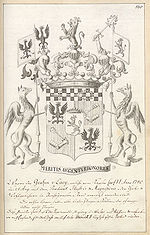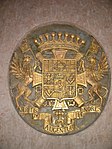Franz Moritz von Lacy
Franz Moritz von Lacy | |
|---|---|
 Count von Lacy | |
| Born | 21 October 1725 Saint Petersburg, Russian Empire |
| Died | 24 November 1801 (aged 76) Vienna, Archduchy of Austria, Holy Roman Empire |
| Buried | Neuwaldegg, Vienna |
| Allegiance | |
| Service/ | Habsburg Empire |
| Years of service | 1743–1790s |
| Battles/wars | War of the Austrian Succession
Austro-Turkish War |
| Relations | Peter Graf von Lacy (father) |
| Signature | |
Franz Moritz Graf
Early life

He was born as the son of Count
Seven Years' War
In 1756 with the opening of the
Lacy, a lieutenant field-marshal at thirty-two, was made chief of staff (quartermaster-general) to Daun in the newly created general staff. They were cautious to the point of timidity since
Later career

After the


In the brief and uneventful
Ancestry
His father was the Irish-born Russian field marshal and general, commander of Saint Petersburg and Veliky Novgorod as well as governor of Riga, Count Pierce Edmond de Lacy (German: Peter Graf von Lacy) (1678–1751).
| Ancestors of Franz Moritz von Lacy | |||||||||||||||||||||||||||||||||||||||||||||||||||||||||||||||||||||||||||||||||||||||||||||||||||||||||||||||||||||||||||||||||||||||||||||||||||||||||||||||||||||||||||||||||||||||||||||||||||||||||||||||||||||||||||||||||||||||||||||||||||||||||||||||||||||||||
|---|---|---|---|---|---|---|---|---|---|---|---|---|---|---|---|---|---|---|---|---|---|---|---|---|---|---|---|---|---|---|---|---|---|---|---|---|---|---|---|---|---|---|---|---|---|---|---|---|---|---|---|---|---|---|---|---|---|---|---|---|---|---|---|---|---|---|---|---|---|---|---|---|---|---|---|---|---|---|---|---|---|---|---|---|---|---|---|---|---|---|---|---|---|---|---|---|---|---|---|---|---|---|---|---|---|---|---|---|---|---|---|---|---|---|---|---|---|---|---|---|---|---|---|---|---|---|---|---|---|---|---|---|---|---|---|---|---|---|---|---|---|---|---|---|---|---|---|---|---|---|---|---|---|---|---|---|---|---|---|---|---|---|---|---|---|---|---|---|---|---|---|---|---|---|---|---|---|---|---|---|---|---|---|---|---|---|---|---|---|---|---|---|---|---|---|---|---|---|---|---|---|---|---|---|---|---|---|---|---|---|---|---|---|---|---|---|---|---|---|---|---|---|---|---|---|---|---|---|---|---|---|---|---|---|---|---|---|---|---|---|---|---|---|---|---|---|---|---|---|---|---|---|---|---|---|---|---|---|---|---|---|---|---|---|---|
| |||||||||||||||||||||||||||||||||||||||||||||||||||||||||||||||||||||||||||||||||||||||||||||||||||||||||||||||||||||||||||||||||||||||||||||||||||||||||||||||||||||||||||||||||||||||||||||||||||||||||||||||||||||||||||||||||||||||||||||||||||||||||||||||||||||||||
See also
- Irish military diaspora
- Irish regiments
References
This article includes a list of general references, but it lacks sufficient corresponding inline citations. (December 2016) |
- ^ Regarding personal names: Until 1919, Graf was a title, translated as Count, not a first or middle name. The female form is Gräfin. In Germany, it has formed part of family names since 1919.
- ^ Edward de Lacy-Bellingari (1928), The roll of the house of Lacy: pedigrees, military memoirs and synoptical history of the ancient and illustrious family of De Lacy, from the earliest times, in all its branches, to the present day. Full notices on allied families and a memoir of the Brownes (Camas). Baltimore, MD: Waverly Press, viii & 409 pp. (accessible online)
- ^ Newerkla, Stefan Michael (2020), "Das irische Geschlecht O'Reilly und seine Verbindungen zu Österreich und Russland" [The Irish O'Reilly family and their connections to Austria and Russia]. In: Diachronie – Ethnos – Tradition: Studien zur slawischen Sprachgeschichte [Diachrony – Ethnos – Tradition: Studies in Slavic Language History]. Eds. Jasmina Grković-Major, Natalia B. Korina, Stefan M. Newerkla, Fedor B. Poljakov, Svetlana M. Tolstaja. Brno: Tribun EU, pp. 259–279 (accessible online), here pp. 259–261.
- ^ a b c d e Chisholm 1911.
Further reading
- "Franz Moritz von Lacy", Allgemeine Deutsche Biographie (ADB) (in German), Volume 17, Leipzig: Duncker & Humblot, 1883, pp. 487–499; (accessible online).
- Johannes Kunisch (1982), "Lacy, Franz Moritz Graf v.", Neue Deutsche Biographie (in German), vol. 13, Berlin: Duncker & Humblot, p. 382; (full text online).
- Edward de Lacy-Bellingari (1928), The roll of the house of Lacy: pedigrees, military memoirs and synoptical history of the ancient and illustrious family of De Lacy, from the earliest times, in all its branches, to the present day. Full notices on allied families and a memoir of the Brownes (Camas). Baltimore, MD: Waverly Press, viii & 409 pp. (accessible online).
- Stefan Michael Newerkla (2019), "Die irischen Reichsgrafen von Browne-Camus in russischen und österreichischen Diensten. Vom Vertrag von Limerick (1691) bis zum Tod ihres Hausfreunds Ludwig van Beethoven (1827)" [= The Irish counts of Browne-Camus in Russian and Austrian service. From the Treaty of Limerick (1691) to the death of their friend Ludwig van Beethoven (1827)]. In: Lazar Fleishman – Stefan Michael Newerkla – Michael Wachtel (eds.): Скрещения судеб. Literarische und kulturelle Beziehungen zwischen Russland und dem Westen. A Festschrift for Fedor B. Poljakov (= Stanford Slavic Studies, Volume 49). Berlin: Peter Lang, pp. 43–68.
- Stefan Michael Newerkla (2020), "Das irische Geschlecht O'Reilly und seine Verbindungen zu Österreich und Russland" [The Irish O'Reilly family and their connections to Austria and Russia]. In: Diachronie – Ethnos – Tradition: Studien zur slawischen Sprachgeschichte [Diachrony – Ethnos – Tradition: Studies in Slavic Language History]. Eds. Jasmina Grković-Major, Natalia B. Korina, Stefan M. Newerkla, Fedor B. Poljakov, Svetlana M. Tolstaja. Brno: Tribun EU, pp. 259–279 (accessible online), here pp. 259–261.
- This article incorporates text from a publication now in the public domain: Chisholm, Hugh, ed. (1911). "Lacy, Franz Moritz, Count". Encyclopædia Britannica. Vol. 16 (11th ed.). Cambridge University Press. p. 57.
